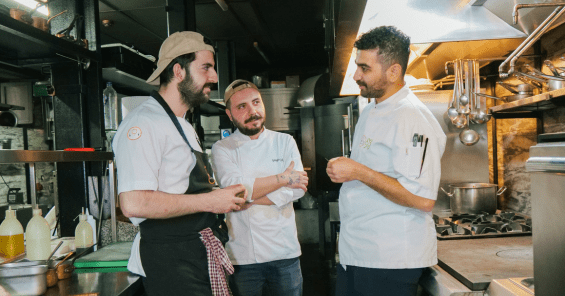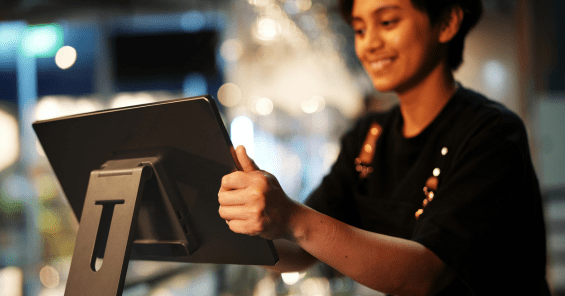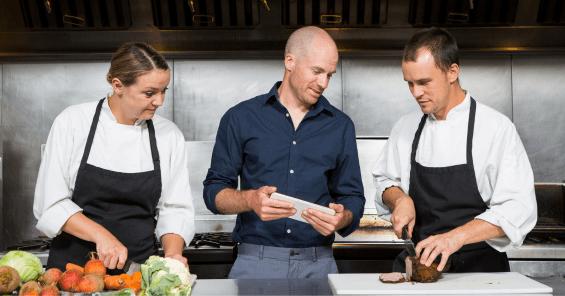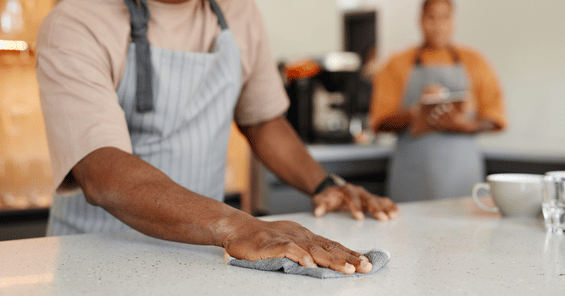
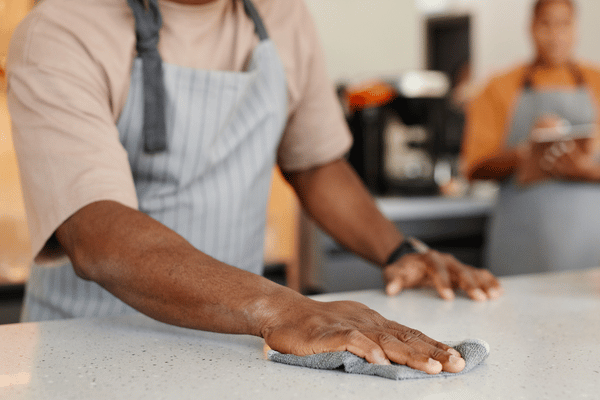
Restaurant Cleaning 101: Everything You Need to Know
Discover the ultimate guide to restaurant cleaning: Learn essential tips, strategies, and checklists to maintain a pristine dining environment, enhance customer satisfaction, and ensure operational efficiency.
Spring cleaning is upon us once again and the interior (and exterior) of your restaurant is also likely due for a good scrub.
A thorough cleaning of your restaurant does more than simply reset for a new season. Consistent restaurant cleaning encourages customers to stay longer, increases average check sizes, ensures operational efficiency, and drives repeat business.
Every nook and corner of your restaurant requires regular inspection, cleaning, and maintenance, and guests take notice. 81% of diners will leave an establishment if they encounter dirty bathrooms, and almost half of customers inspect the state of their cutlery.
Mopping floors is likely on your daily closing checklist, but pressure washing your hood filters doesn’t have to be a daily occurrence. Organizing cleaning tasks ahead of time and creating a consistent schedule will set your business up for sparkling success.
Restaurant Cleaning Checklist
Standardize your restaurant’s cleaning procedures with a comprehensive checklist broken down into daily, weekly, and monthly tasks. Easily tackle and track all cleaning activities from daily mopping of kitchen floors to monthly deep cleaning of heavy equipment.

The Importance of a Restaurant Cleaning Checklist
It’s common for restaurant staff members, including front-of-house and kitchen employees, to carry out daily cleaning tasks such as wiping down surfaces, mopping floors, and washing equipment and utensils. However, ensuring every area of your business is clean can become overwhelming without a proper system in place.
You might find it convenient to let a staff member volunteer to clean the fryer on the spot. However, if you fail to properly schedule this task, you could face a busy period with customers expecting your famous fried pickles, only to find you can't prepare or serve them.
Whether your staff wipes down their stations before closing for the night, or a third-party cleaning service deep cleans before the next shift, there are certain things you need on a scheduled restaurant cleaning checklist.
A restaurant cleaning checklist is an essential, powerful tool that helps organize a list of cleaning activities to create a hygienic dining environment, ensure all areas of a restaurant meet health regulations, and help staff manage their time more effectively.
Each area of your restaurant business requires its own list of cleaning tasks. These areas include:
- Kitchen
- Bar
- Restrooms
- Storage
- Dining space
- Outdoor seating
Restaurant Cleaning Services
While everyone from the staff to management is responsible for the cleanliness of a restaurant, both independent and larger chains can benefit from hiring a third-party cleaning service to complete specialized deep cleaning tasks.
Third-party restaurant cleaning services cover a variety of tasks that might be too challenging or time-consuming for restaurant staff to complete. These can include waxing and sealing floors, cleaning ductwork and exhaust systems, and washing windows.
How Much Does a Restaurant Cleaning Service Cost?
The cost of a restaurant cleaning service depends on the type and frequency of service, the size of the restaurant, and potential custom services. Hourly rates vary between $20 and $150 an hour and will increase for larger establishments.
Choosing to pay for a cleaning service will depend entirely on your restaurant’s priorities, staff capacity, and current labor costs.
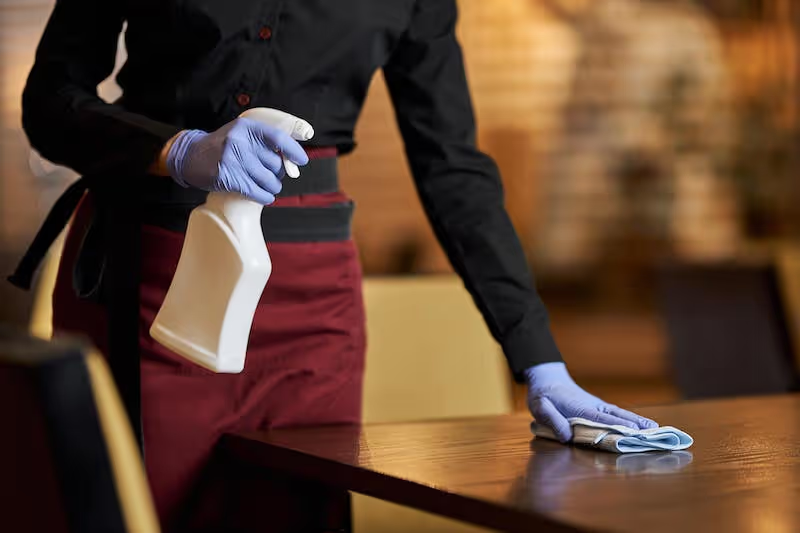
Invest in Restaurant Cleaning Supplies
Whether you’re utilizing cleaning services for those hard-to-reach, time-consuming places, scheduling staff to tidy up across shifts, or implementing a schedule that has a combination of both, you’ll need a basic supply of cleaning supplies on hand.
While a cleaning service may handle deep cleaning tasks, having necessary supplies readily available supports day-to-day upkeep and routine tasks like sanitizing high-touch surfaces, wiping up spills and accidents, and staying flexible to handle unforeseen instances or supply chain disruptions.
Essential restaurant cleaning supplies include:
- Mops, Brooms, Vacuums, Buckets
- All-purpose cleaner
- Degreaser
- Disinfectants
- Steam cleaners
- Microfiber cloths
- Cleaning gloves
How to Implement a Restaurant Cleaning Checklist
Customize According to Your Needs
While the basic components of a restaurant cleaning checklist are similar, each restaurant will have unique needs when it comes to specific tasks and their frequency.
For larger operations, the cleaning checklist may include more detailed tasks for multiple zones within the restaurant, while smaller establishments may focus on a handful of areas due to limited staff.
Customize your checklist based on the layout, size, traffic volume, and type of your restaurant.
Schedule Cleaning Tasks
Determine which tasks need to be done daily, weekly, and monthly. This will help spread out the workload and ensure nothing is overlooked. Prioritize daily tasks that have an immediate impact on food safety and service. This includes cleaning and sanitizing all surfaces that come into contact with food, such as cutting boards, countertops, cooking equipment, and utensils.
Restaurant Managers should inspect the cleanliness of the kitchen and the status of equipment as part of their Opening Checklist to ensure smooth operations. Use separate checklists for each frequency category to ensure that all tasks are completed at the correct intervals.
Assign Responsibilities
Assign tasks to specific staff members or teams to divide and conquer tasks around your restaurant, getting the job done faster and ensuring everyone pitches in. Communicate your cleaning standards from the start during training sessions with scheduled demonstrations, visual aids, or shadowing.
Recognize and reward staff and teams that consistently execute well on cleaning tasks to boost morale and foster good examples for other employees.

Monitor and Update
Regularly review the effectiveness of your cleaning schedule and make adjustments as necessary to address new challenges or changes in your operation. Schedule unexpected audits to identify areas of improvement and update your checklist.
Keep tabs on local health and safety regulations to remain compliant and maintain a positive health score.
Common Restaurant Cleaning Tasks
Restaurant cleaning checklists include a variety of daily, weekly, and monthly tasks to maintain staff safety, customer satisfaction, and general cleanliness. These tasks range from routine sweeping and mopping of floors to more deep cleaning of equipment and harder-to-reach places.
Daily Restaurant Cleaning Checklist
- Remove debris and trash: Empty all trash cans and recycling bins from the kitchen, dining area, and restroom. Remove all debris surrounding the outside dumpsters to prevent pests. If you’re noticing more waste than usual, it’s time to conduct a waste audit.
- Sweep and mop floors: Sweep, mop, and vacuum all areas of the restaurant to pick up loose debris, remove stains and debris, and wipe up spillages.
- Sanitize all surfaces: Use a damp cloth and disinfectant spray to clean tables, counters, door handles, and menus.
- Reset restrooms: Sanitize high-touch points including toilets, sinks, and door handles before opening, restock supplies like soap and paper towels hourly during operation, especially after peak periods, and conduct a deep clean after closing.
- Wipe down kitchen equipment: Clean grills, stovetops, and other cooking surfaces to remove grease and food particles.
Weekly Restaurant Cleaning Checklist
- Deep clean the floors: Steam clean the floors and thoroughly scrub stubborn stains.
- Clean the refrigerator: Remove all items, wipe shelves with a food-safe sanitizer, clean the condenser coils, and check the expiration dates of inventory.
- Wash and sanitize the ice machine: Wipe down the exterior with a soft cloth and check the air filter for dust and debris.
- Deep clean ovens and grills: Remove built-up grease and food debris.
- Dust and clean light fixtures and decor: Dust all light fixtures, lamps, and ceiling fans using a microfiber cloth or a duster with an extendable handle to reach high areas
Monthly Restaurant Cleaning Checklist
- Inspect the exhaust hoods: Thoroughly clean the interior and exterior of the exhaust hoods with a degreaser.
- Descale sinks and faucets: Use a descaling solution to remove lime and mineral build-ups from sinks and faucets.
- Check and clean HVAC vents: Remove dust or debris that could affect air quality from the vents.
- Deep clean carpets and upholstery: Utilize professional-grade carpet cleaners or steam cleaners to remove stains, dirt, and allergens.
Download our detailed restaurant cleaning checklist to keep your team organized and efficient here.
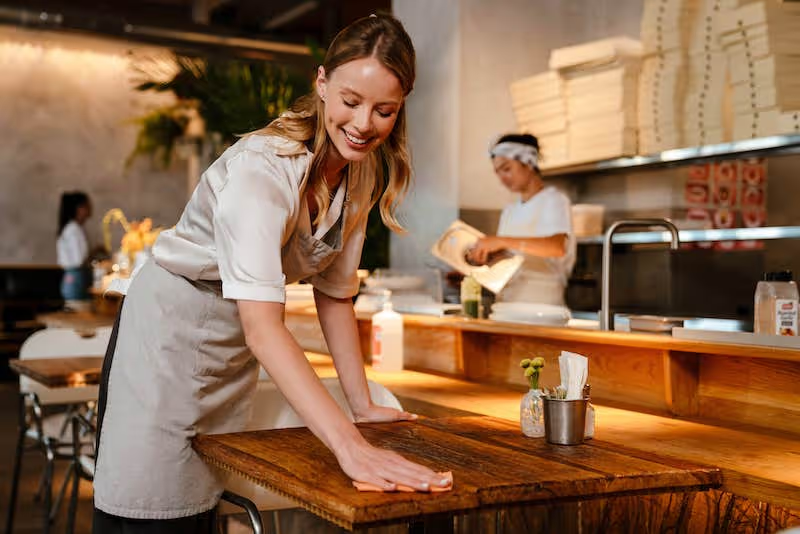
4 Restaurant Cleaning Tips
Implement a Hand Washing Policy
Require staff members to wash their hands regularly to prevent the spread of bacteria and cross-contamination. All employees must wash their hands for at least 20 seconds with soap before and after handling food, after using the restroom, after handling a cell phone, and after taking out the trash or touching other waste material. Post laminated hand washing guidelines by sinks to ensure staff follow proper protocol.
Utilize an Equipment Preventative Maintenance Checklist
Regular cleaning of restaurant equipment is part of preventative care, but sometimes appliances require more extensive maintenance and service. Implement a restaurant equipment preventative maintenance checklist organized into daily, weekly, and annual tasks to extend appliance lifespan, avoid costly fixes, and ensure optimal performance.
Minimize Cell Phone Usage
Cell phones carry a lot of germs. Research has shown that the average phone has 25,127 bacteria every square inch. That’s three times the number of germs that dirty doorknobs have.
With this in mind, ask staff members to limit their phone usage during their shifts to prevent germs from spreading to food, menus, cutlery, and appliances.
Run Regular Food Inventory Checks
Food inventory management is a critical aspect of maintaining a clean, organized, and profitable restaurant kitchen. Regular inventory checks enable restaurateurs to identify items nearing their expiration dates, allowing them to incorporate these items into their menus before it’s too late. These checks also help identify popular ingredients that are depleting quickly, enabling a prompt reorder from vendors.
By implementing a daily or weekly routine inventory schedule, restaurateurs prevent overstocking, minimize waste, and plan more profitable menus with fresh ingredients.

Gain a bird’s eye view of your kitchen’s inventory and optimize all back-of-house operations with MarketMan’s cloud-based restaurant management software. Automate your inventory management, generate reports on COGS, Actual vs Theoretical usage, and gross profits, reduce waste, and streamline your ordering processes. With MarketMan, restaurateurs can take inventory counts on the go using a tablet or smartphone. Just keep the hand-washing policy in mind. Schedule a demo today to see it in action.
Author
Contributors
If you have any questions or need help, feel free to reach out
Don't miss out on maximizing your restaurant's profits! Calculate your ROI with MarketMan
Join over 18,000 restaurants and get the hottest restaurant tips delivered to your inbox
You may also be interested in
Ready to get started?
Talk to a restaurant expert today and learn how MarketMan can help your business



